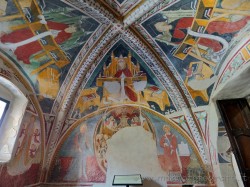|
Occhieppo Superiore (Biella)- Church of Santo Stefano
|
|
|
Show to visit in the Biella area: |
 The Church of Santo Stefano in Occhieppo Superiore has very ancient origins, as the first document in which it is mentioned is a bull of Pope Urban III of 1186. Originally it depended on the collegiate church of Biella. The Church of Santo Stefano in Occhieppo Superiore has very ancient origins, as the first document in which it is mentioned is a bull of Pope Urban III of 1186. Originally it depended on the collegiate church of Biella.
At the beginning of the seventeenth century the original church was rebuilt and replaced with the current one, in Baroque style. Of the previous church there remaines only a chapel, now placed to the left of the presbytery, looking from the entrance.
The lower part of the bell tower, moreover, coincides with the remains of the tower of the medieval castle that at the end of the fourteenth century was devastated by Facino Cane, and then largely destroyed in 1527 by Filippo Tornielli in the war between France and Spain.
The building was enlarged in the following century, with the addition of a façade in 1727, which remained unfinished until 1865, and of the choir in 1760.
The current church has three naves, with a central nave with a barrel vault and side aisles with a cross vault.
The ceiling of the central nave is not decorated itself and its smooth surface is underlined by the clear separation from the side walls through a trabeation with a marked horizontal structure. But around the side windows that open in the vault there are decorations in Baroque style.
The presbytery is richly decorated and divided into two parts; a rectangular part with a dome decorated with trompe l'oeil frescoes to suggest a colonnade supporting the dome, and a trilobed choir. In the presbytery the colors of wine red and bottle green predominate, present on the side panels next to the main altar, within which coats of arms are represented. The red wine color can also be found on the high altar in polychrome marble, in the large frame of the canvas on the back wall depicting the martyrdom of Santo Stefano (Rodolfo Morgari, ca. 1870) and on the decorations of the vaults. The four evangelists are represented on the plumes of the dome, again a work of Rodolfo Morgari.
The large wooden crucifix of the fifteenth century is also worthy of mention in the presbytery. In it "the figure of Christ is characterized by a strong anatomical definition of the chest, broad and robust, underlined by the ribs in evidence, wide hips with a rather narrow waistline, and finally by the powerful legs".
The Chapel of Our Lady of the Rosary is interesting (Fig. 4), as in it there is an altarpiece probably from 1860, inside a stucco frame of classical taste, which in reality depicts a Madonna of the Belt, that is a Virgin and Child flanked by a holy bishop on the left, to be recognized in Saint Augustine, and by Saint Monica on the right, who wears the black dress of the Augustinian nuns with a buckle belt that surrounds her waist.
At the head of the left aisle it is possible to appreciate a beautiful polychrome marble altar dedicated to the Sacred Heart, represented also in the altarpiece (Sacred Heart of Jesus and the saints Antonio Abate, Mary Magdalene and Lucia, by Rodolfo Morgari, 1867).
At the end of the right aisle, instead, the altar of San Giulio, dedicated to Our Lady of Sorrows.
The highlight of the church is however represented by the chapel on the left of the presbytery, the only part arrived intact to us of the original church. The walls and the ceiling of the chapel, previously used as a sacristy and then as a deposit and finally completely restored in 2015, are completely decorated with splendid fifteenth-century frescoes. The frescoes, painted during the last two decades of the fifteenth century, represent a Deposition of Christ and an Assumed Virgin on the north wall (large picture); a Coronation of the Virgin of Mercy with Santo Stefano and San Quirico on the East wall; busts of prophets and kings of Israel on the intrados of the arches and the four Doctors of the Church (Ambrose, Augustine, Jerome and Gregory) on the sails of the vault.
To note in various scenes the presence of bunnies, which in the religious field, due to the fact of being born in Spring, are a symbol of resurrection.
The frescoes appear to have been painted by three different workshops, including that of Daniele de Bosis.
Worthy of mention in the church also the martyrdom of St. Stephen (polychrome wooden sculpture by Nicolao Serpentiere from 1666), the fourteen stations of the Via Crucis by Pietro Antonio Serpentiere (descendant of Nicolao Serpentiere) from 1810-11, the walnut wood pulpit with panels of a singular design of the end of the seventeenth century.
The already mentioned façade is in two orders and in late Baroque style with already neoclassical tendencies, that is very sober and linear. The lower order is dominated by the ornate door with a wooden group, representing the martyrdom of St. Stephen and dating back to the first half of the eighteenth century.
At the center of the second order, a large rose window and finally, at the top, a large triangular pediment.
Categories: Places of historical value of artistic value
Piazza Mons. Maffeo, 13, 13898 Occhieppo superiore BI |
Church of Santo Stefano: Further pictures in the section Photography |